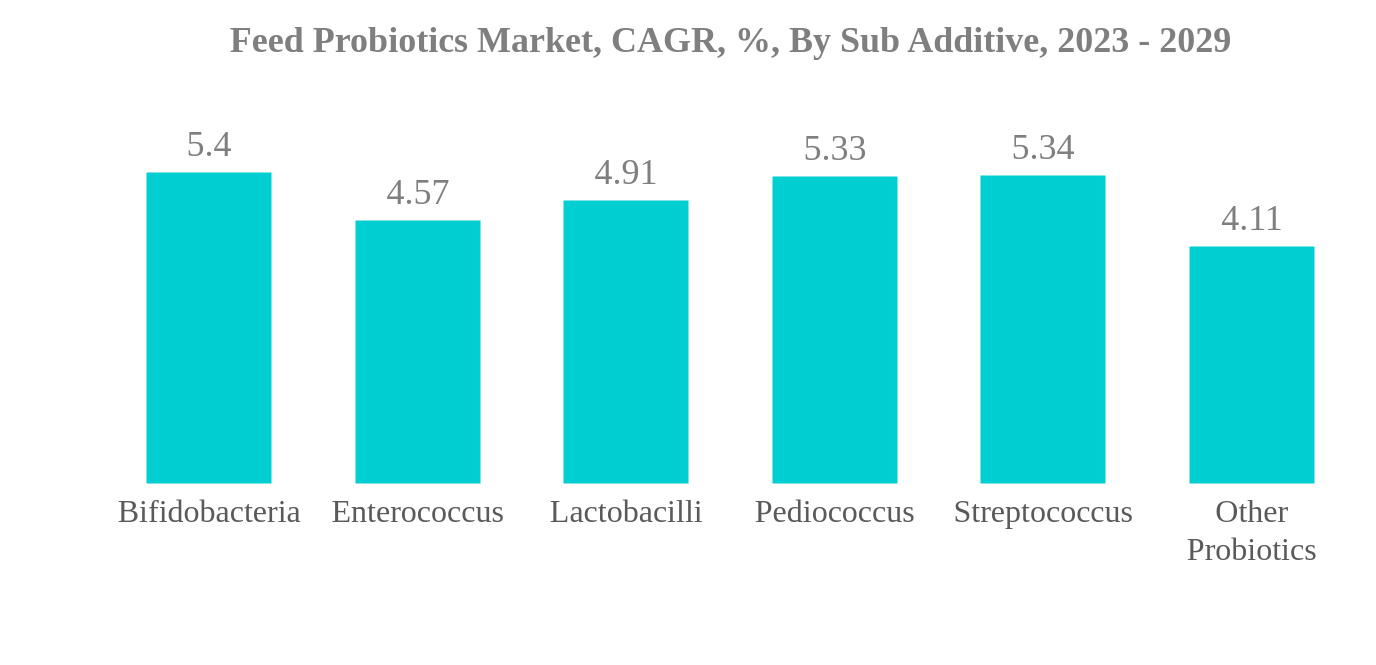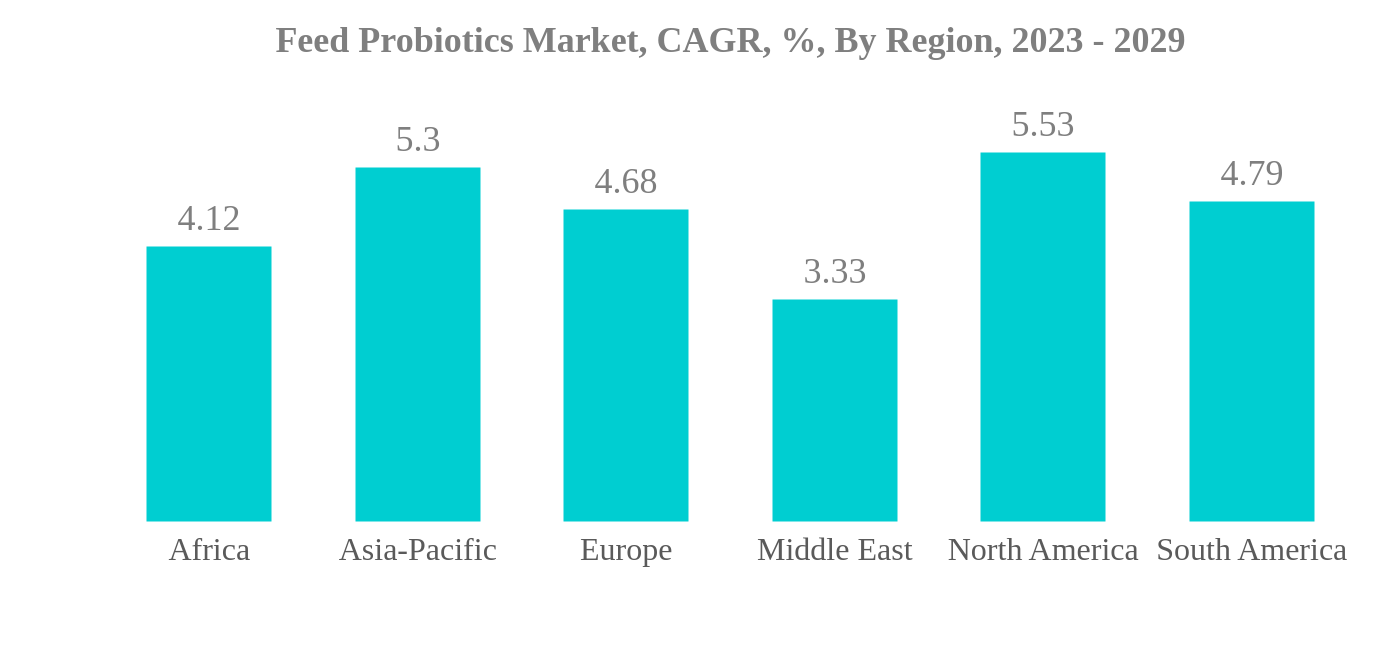Need help finding what you are looking for?
Contact Us
PUBLISHER: Mordor Intelligence | PRODUCT CODE: 1273326

PUBLISHER: Mordor Intelligence | PRODUCT CODE: 1273326
Feed Probiotics Market - SIZE, SHARE, & FORECASTS UP TO 2029
PUBLISHED:
PAGES: 383 Pages
DELIVERY TIME: 2-3 business days
SELECT AN OPTION
The Feed Probiotics Market is projected to register a CAGR of 5.06%
Key Highlights
- Bifidobacteria is the Largest Sub Additive : Bifidobacteria is the largest segment due to the rising demand for meat and seafood and reducing the growth of harmful microorganisms in the gastrointestinal tract of animals.
- Asia-Pacific is the Largest Region : The Asia-Pacific region is the largest regional segment, having the highest poultry population, increased feed production, and high demand for meat and end-products.
- Bifidobacteria is the Fastest-growing Sub Additive : Bifidobacteria is the fastest-growing segment due to high consumption in Asia-Pacific, reducing diseases such as campylobacteriosis and helping animals to gain body weight.
- North America is the Fastest-growing Region : North America is the fastest-growing region because of increased feed production, major feed mills in the United States, and high demand for meat products.
Feed Probiotics Market Trends
Bifidobacteria is the largest Sub Additive
- The global feed additives market has seen a significant increase in the consumption of probiotics. In 2022, probiotics held a market share of 8.3%. This is due to their ability to enhance the growth and production of animals, protect against pathogens, improve bone strength, enhance the immune system, and fight parasitism. The market is expected to grow and register a CAGR of 5.1% during the forecast period.
- Bifidobacteria and lactobacilli are the two major sub-additives consumed globally, together accounting for 63.5% of the global feed probiotics market in 2022. Lactobacilli stimulate the digestive system, fight disease-causing bacteria, and help produce vitamins. Bifidobacteria helps in weight gain and improve animal health.
- Poultry birds were the largest animal type segment in the global feed probiotics market, accounting for 46.8% of the market share by value in 2022. The increased usage of feed probiotics in poultry birds is due to their ability to promote growth performance and overall health.
- The largest consumers of feed probiotics globally are Asia-Pacific and North America. In 2022, the United States held the largest market share, accounting for 70.0% of the North American feed probiotic market. In the Asia-Pacific region, China is the major market for feed probiotics, accounting for 43.9% of the region's feed probiotics market by value. This is due to the high livestock population in the country, with China accounting for 41.0% of the Asia-Pacific's poultry population in 2022.
- Therefore, the use of probiotics in feed additives is expected to grow due to their ability to improve the digestive system, prevent diseases, and increase feed production. This provides an opportunity for manufacturers to expand their offerings.

Asia-Pacific is the largest Region
- The global feed probiotics market experienced impressive growth in recent years. Probiotics are essential nutrients that help enhance animal growth and development while strengthening immune systems and protecting the animals from diseases. During 2017-2022, the global feed probiotics market grew by 29.7%, representing 8.3% of the overall feed additive market.
- In 2022, Asia-Pacific was the largest market for feed probiotics, with a value of USD 883.2 million due to the region's higher penetration rates and higher commercial cultivation of animals. At the country level, the United States was the largest market for feed probiotics, accounting for almost 18.5% of the global market share, with a value of USD 505.8 million in 2022. The United States occupied a dominant position due to its highly developed production practices and significant commercial animal cultivation.
- China was the second-largest market for feed probiotics, accounting for 14.2% of the global market share in 2022 due to its large animal headcount. However, Japan and the United States are the fastest-growing countries in the world, and they are expected to record a CAGR of 6.2% and 6.0%, respectively, during the forecast period due to the rising demand for feed production and increased usage of feed probiotics as ingredients for piglets and calves.
- The global feed probiotics market is expected to register a CAGR of 5.1% during the forecast period, driven by the growing concerns of rising productivity, increasing global population, and urbanization. The increased consumption of meat and dairy products is also expected to fuel the market's growth.

Feed Probiotics Industry Overview
The Feed Probiotics Market is moderately consolidated, with the top five companies occupying 51.79%. The major players in this market are Adisseo, Cargill Inc., DSM Nutritional Products AG, Evonik Industries AG and IFF(Danisco Animal Nutrition) (sorted alphabetically).
Additional Benefits:
- The market estimate (ME) sheet in Excel format
- 3 months of analyst support
Product Code: 55743
TABLE OF CONTENTS
1 EXECUTIVE SUMMARY & KEY FINDINGS
2 REPORT OFFERS
3 INTRODUCTION
- 3.1 Study Assumptions & Market Definition
- 3.2 Scope of the Study
- 3.3 Research Methodology
4 KEY INDUSTRY TRENDS
- 4.1 Animal Headcount
- 4.2 Feed Production
- 4.3 Regulatory Framework
- 4.4 Value Chain & Distribution Channel Analysis
5 MARKET SEGMENTATION
- 5.1 Sub Additive
- 5.1.1 Bifidobacteria
- 5.1.2 Enterococcus
- 5.1.3 Lactobacilli
- 5.1.4 Pediococcus
- 5.1.5 Streptococcus
- 5.1.6 Other Probiotics
- 5.2 Animal
- 5.2.1 Aquaculture
- 5.2.1.1 By Sub Animal
- 5.2.1.1.1 Fish
- 5.2.1.1.2 Shrimp
- 5.2.1.1.3 Other Aquaculture Species
- 5.2.2 Poultry
- 5.2.2.1 By Sub Animal
- 5.2.2.1.1 Broiler
- 5.2.2.1.2 Layer
- 5.2.2.1.3 Other Poultry Birds
- 5.2.3 Ruminants
- 5.2.3.1 By Sub Animal
- 5.2.3.1.1 Beef Cattle
- 5.2.3.1.2 Dairy Cattle
- 5.2.3.1.3 Other Ruminants
- 5.2.4 Swine
- 5.2.5 Other Animals
- 5.2.1 Aquaculture
- 5.3 Region
- 5.3.1 Africa
- 5.3.1.1 By Country
- 5.3.1.1.1 Egypt
- 5.3.1.1.2 Kenya
- 5.3.1.1.3 South Africa
- 5.3.1.1.4 Rest Of Africa
- 5.3.2 Asia-Pacific
- 5.3.2.1 By Country
- 5.3.2.1.1 Australia
- 5.3.2.1.2 China
- 5.3.2.1.3 India
- 5.3.2.1.4 Indonesia
- 5.3.2.1.5 Japan
- 5.3.2.1.6 Philippines
- 5.3.2.1.7 South Korea
- 5.3.2.1.8 Thailand
- 5.3.2.1.9 Vietnam
- 5.3.2.1.10 Rest Of Asia-Pacific
- 5.3.3 Europe
- 5.3.3.1 By Country
- 5.3.3.1.1 France
- 5.3.3.1.2 Germany
- 5.3.3.1.3 Italy
- 5.3.3.1.4 Netherlands
- 5.3.3.1.5 Russia
- 5.3.3.1.6 Spain
- 5.3.3.1.7 Turkey
- 5.3.3.1.8 United Kingdom
- 5.3.3.1.9 Rest Of Europe
- 5.3.4 Middle East
- 5.3.4.1 By Country
- 5.3.4.1.1 Iran
- 5.3.4.1.2 Saudi Arabia
- 5.3.4.1.3 Rest Of Middle East
- 5.3.5 North America
- 5.3.5.1 By Country
- 5.3.5.1.1 Canada
- 5.3.5.1.2 Mexico
- 5.3.5.1.3 United States
- 5.3.5.1.4 Rest Of North America
- 5.3.6 South America
- 5.3.6.1 By Country
- 5.3.6.1.1 Argentina
- 5.3.6.1.2 Brazil
- 5.3.6.1.3 Chile
- 5.3.6.1.4 Rest Of South America
- 5.3.1 Africa
6 COMPETITIVE LANDSCAPE
- 6.1 Key Strategic Moves
- 6.2 Market Share Analysis
- 6.3 Company Landscape
- 6.4 Company Profiles
- 6.4.1 Adisseo
- 6.4.2 Cargill Inc.
- 6.4.3 CHR. Hansen A/S
- 6.4.4 DSM Nutritional Products AG
- 6.4.5 Evonik Industries AG
- 6.4.6 IFF(Danisco Animal Nutrition)
- 6.4.7 Kemin Industries
- 6.4.8 Kerry Group Plc
- 6.4.9 Lallemand Inc.
- 6.4.10 MIAVIT Stefan Niemeyer GmbH
7 KEY STRATEGIC QUESTIONS FOR FEED ADDITIVE CEOS
8 APPENDIX
- 8.1 Global Overview
- 8.1.1 Overview
- 8.1.2 Porter's Five Forces Framework
- 8.1.3 Global Value Chain Analysis
- 8.1.4 Global Market Size and DROs
- 8.2 Sources & References
- 8.3 List of Tables & Figures
- 8.4 Primary Insights
- 8.5 Data Pack
- 8.6 Glossary of Terms
Have a question?


SELECT AN OPTION
Have a question?


Questions? Please give us a call or visit the contact form.
